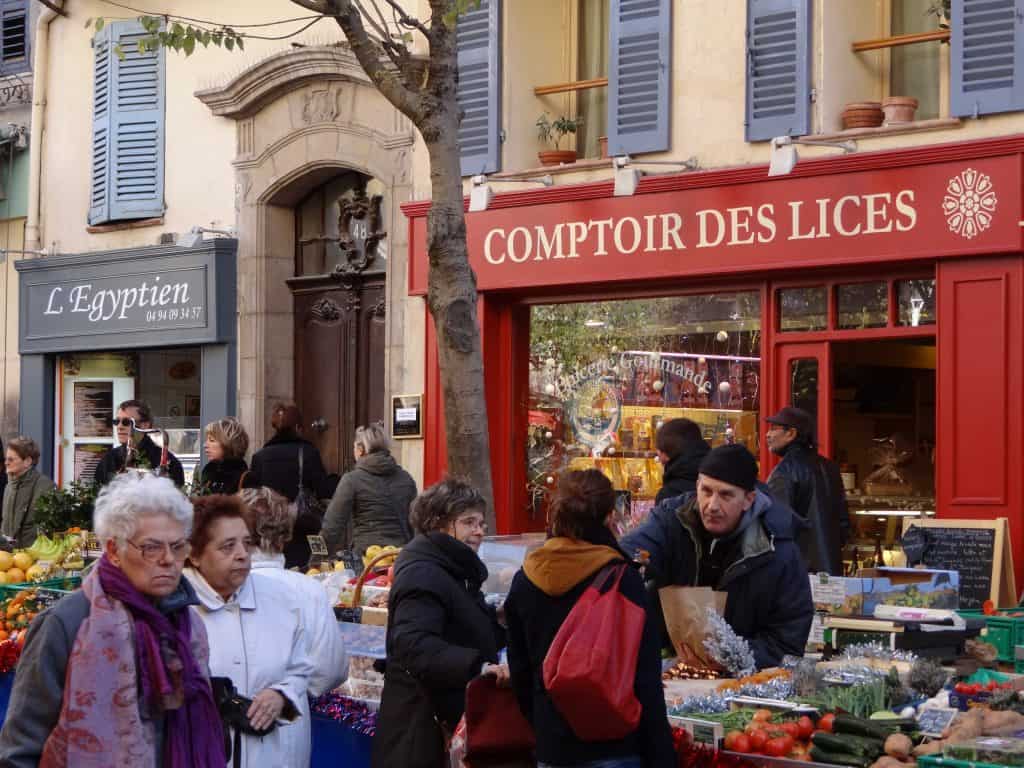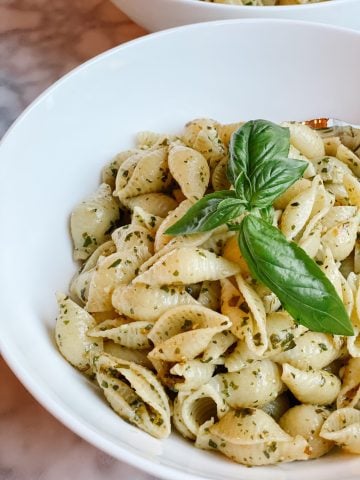
J'Adore! Would you like to save this recipe?
This is one French Christmas tradition that is easier to create than it sounds. The 13 Desserts are a Provençal Christmas tradition that have much more to do with laying out a sweet spread for your family and guests to pick from then making thirteen intricate desserts. A sweet grazing board, if you will, that pairs wonderfully with mulled wine on Christmas Eve and lasts through to hot coffee on Christmas morning.
I first heard of The 13 desserts when spending my first Christmas abroad with my new fiancé's family in Toulon, France. My mother in law took me on a Christmas Eve shopping expedition to the Mourillon Market. It is a street-long shopping experience in Toulon that starts with an open air market that fills a parking lot and ends with a beautiful view over the Mediterranean sea. On Christmas Eve the street was filled with determined shoppers, weaving in and out of stalls and shops with their market bags and wheeled shopping trolleys. We could not go more than 2 feet without someone stopping to give 3 enthusiastic kisses on her, then my, cheeks. Ma belle fille! (my daughter in law)Adrienne would proclaim to each person.

Christmas Eve Market in Toulon
As we walked from one stall to the next, Adrienne educated me on the virtues of one vendor's dried figs over another's. "Tsk tsk" she would say sharply when one display caught my eye. Only figs from Solliès Pont would do! Fruits confits from the town of Apt. Calissons from the city of Aix-en-Provence. Not only was this a lesson in culinary creations I had never heard of, it was also a geography lesson! Each town in Provence being the proud producer of a singular specialty.
We stood in line at "la Boulangerie"(bakery) to buy a hot "Pompe à l'huile" fresh out of the oven. One for the walk home and one for the table, Adrienne winked at me, our treat! The delicate aroma of orange blossom so irresistible - la Pompe barely made it a block!
Only when our market bags were filled to the brim and heavy to carry did we start to head home, ready for the festivities of Christmas.

Les Treize Desserts - The Thirteen Desserts
Historically, Provence is not a region known for its fine pastry. The people of Provence worked the land and didn't spend time in the court of Versailles sampling pâte à chou and macarons. Desserts, as they are referred to, are sweet treats that farmers would have been able to make at home with their crops or what was readily available. My great grandmother in law would spend months preparing The Thirteen desserts on her family farm. Drying the dates and figs from their trees. Harvesting the almonds and walnuts.
La Pompe a l'Huile bread- the "oil pump" sounds so weird but is so good! Olive farmers would pour flour in the bottom of their empty vats of olive oil to soak up every last drop of liquid. They then took the flour imbibed in olive oil to the local baker who would prepare it into a flat dough that is so delicious - it needs to be sampled. While La Pompe à l'huile is baked in the oven it strongly resembles a fry bread. Nothing went to waste in Provence at winter time.
Types of Desserts in The 13 desserts:
The 13 desserts fall into several categories - each family is free to pick and choose from these selections to create a delicious grazing board of sweets. The only rule is that there be 13 desserts in total!
Fresh Fruits
- Clementines
- Oranges
- Pears
- Apples
- Winter melon
- Green grapes

Dried Fruit
- Figs
- Dates
- Prunes
- Golden Raisins

Nuts/Seeds
- Walnuts
- Almonds
- Hazelnuts
- Chestnuts
- Cashews
- Pecans
Sweets
- Fruits confits or candied fruit
- Nougat (black and/or white) you can order French nougat here
- Calissons (almond paste candies from Aix-en-Provence) you can order them here.
- Fig Jam (I love the one by Bonne Maman)
- Pâte de fruits (Fruit Jelly)

Baked Goods
- La Pompe à l'huile à fleur d'oranger
- Oreillettes
- Biscotti with almonds
- Pine nut almond cookies (Croissants aux pignons et amandes)
- Pine nut tart (Tarte aux Pignons)

Frequently Asked Questions:
There is no set list of 13 desserts that must be in Les Treize Desserts, each family is free to assemble the 13 sweet treats that they most enjoy. That being said, there must be 13! The number 13 signifies Jesus and his 12 Apostles.
Traditionally the 13 desserts are laid out after Christmas Eve supper and left out until the day after Christmas. It is a delicious grazing platter that makes Christmas morning even more enjoyable - sampling fruit and nuts while enjoying the festivities and perhaps a morning Panettone. Les 13 desserts are great for when guests pop by - there is something sweet to serve.
On Christmas Eve we serve vin chaud, or mulled wine, with Les 13 desserts. On Christmas morning, I enjoy them with coffee! La Pompe à l'huile is great for dunking in the mulled wine!
Not traditionally. The 13 desserts are enjoyed after the "répas maigre" or lean supper, that is served on Christmas Eve. La Büche de Noël, or Yule Log, is served on Christmas day after the big, festive Christmas lunch.





Other Recipes you will enjoy
25 Best French Holiday Recipes
I would love to know, what are your Christmas traditions?
Au plaisir, mes amis,
Le Chef's Wife

ALL ABOUT LE CHEF'S WIFE

Bonjour! I am Anina Belle. I translate the fancy cooking of my Michelin-star trained French Chef Husband, Le Chef, into easy to make dishes that busy people with no culinary training (like me!) can make at home. We have two young kids (8 and 5) and I run a marketing company and a non-profit in addition to this blog. I strongly believe that even busy people deserve to eat well at home.
Look inside our Kitchen with this Washington Post Article. We were featured on the TODAY SHOW for our recipes of French Onion Soup Gratinée and Moelleux au Chocolat. You can watch our full segment below.
I share our home cooking on Instagram, pinterest and tiktok. Sign up for my newsletter to be the first to receive my new recipes and have advance access to cooking classes. I look forward to cooking with you






Linda says
My good friend, French from the Manosque/Montélimar areas, has lived in DC her entire life. Her lovely mom died recently and she decided to adopt this published tradition for her family and friends, many of whom live in her neighborhood.
If you are still producing your blog, that's such a fun boon for those of us who cook well, love to experiment, but are always looking for other recipes to try on friends and family members who come over to visit. You are absolutely right that people who want to cook French food need not be chefs. Following directions along with having the right fresh ingredients make for a good beginning. Thanks for your efforts.
lechefswife says
Thank you so much for your kind comment Linda! I really appreciate your words and that you took the time to write. Thank you for your support - I agree there is so much fun to be had in cooking beautiful food for loved ones
Linda says
My good friend, French from the Manosque/Montélimar area, has lived in DC her entire life. Her lovely mom died recently and she decided to adopt this tradition for her family and friends, many of whom live in her neighborhood.
If you are still producing your blog, that's such a fun boon for those of us who cook well, love to experiment, but are always looking for other recipes to try on friends and family members who come over to visit. You are absolutely right that people who want to cook French food need not be chefs. Following directions along with having the right fresh ingredients make for a good beginning. Thanks for your efforts.
Suzanne says
What a lovely story! Well told, with great photos, brava!
Where do you get Pompe à l’huile in DC?
lechefswife says
I made it! Can you sense a follow up blog post coming? 🙂